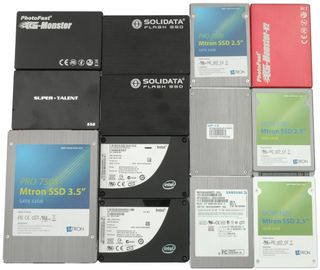Hot or Not? New Samsung and Solidata SSDs

SSD Capacities And Performance On The Move
The market is flooded with flash-based solid state drives (SSD) right now, all of which claim to deliver impressive throughput at power consumption levels low enough to save the world. So much for the theory, though—the reality is rather different.
A few select products are truly impressive, but the bulk of these are just expensive offerings that do not deliver on their promises. Two new drives by Samsung and Solidata found their way into our test labs, and they are as different as they can be.

Power Issues
We stirred up the SSD hive when we reported that many flash SSDs do not actually increase notebook battery runtime by saving power; in fact, they might shorten it due to the high power consumption of the drives. The article The SSD Power Consumption Hoax talks about power consumption issues we found half a year ago; our Flash SSD Update verifies and emphasizes these results. And the power issue is not over. Now that SSDs are exceeding 200 MB/s throughput, they tend to become CPU-bound. In other words, this means that running systems with full power saving settings enabled might bottleneck your SSD performance.
Performance Issues
First- and second-generation flash SSDs simply were not what people had hoped they would be. It took until 2009 for flash SSDs to become more efficient and noticeably faster. Six new drives did well a couple of months ago, but only Intel’s X25-M (consumer) and X25-E (professional) were able to truly impress us.
In addition to this, many tech Web sites are focusing on existing fragmentation issues with flash SSDs today, as the performance characteristics depend on the workload, the data stored, and the fragmentation level. Sequential reads or writes from or to flash SSDs aren’t, in fact, sequential, as intelligent controllers constantly try to optimize performance and wear leveling by distributing writes according to the flash SSD’s capabilities. They are typically successful, while staying within a one-workload scenario.
Stay On the Cutting Edge: Get the Tom's Hardware Newsletter
Get Tom's Hardware's best news and in-depth reviews, straight to your inbox.
However, dramatic changes in workload or capacity reuse may impact flash SSD performance, and only SSD-drive-aware operating systems will be able to improve this situation. Until then, try to avoid heavy fragmentation (P2P downloads) or changing workloads (from intensive I/O to intensive sequential requests). If you use your flash SSD as a system drive, you should be fine, taking advantage of modern flash SSDs’ performance potential.
New Drives: Samsung PB22-J, Solidata X1 and X2
Samsung’s new PB22-J drive finally jumps over the 200 MB/s line, and it is available at capacities of up to 256 GB. Unfortunately, these drives aren’t intended to be sold at retail, though you may see re-labeled Samsung drives, or be able to get them in high-end notebooks.
We also received two Solidata SSDs, which differ by running two individual flash segments in an internal RAID 0 configuration. We found that the drives perform well, but they also require horrible levels of power consumption that actually exceed the amount needed by fast 3.5” desktop drives.
We also included two new Mtron SSDs, the SSD Mobi, which we received from the vendor RocketDisk.com.
Current page: SSD Capacities And Performance On The Move
Next Page Flash SSD Versus Hard Drive